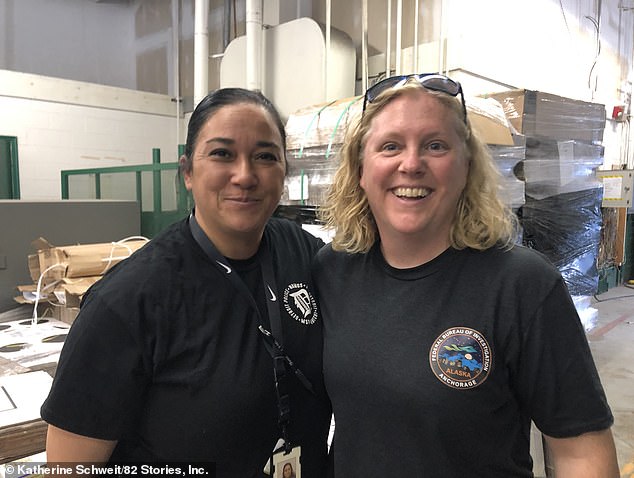
Two female investigators have spent the past five years digging up the bodies of 200 murder victims from Detroit’s backlog of cold cases, hoping to identify and give justice to the dead.
Detective Shannon Jones, of the Detroit Police Department, and FBI Special Agent Leslie Larsen, are the hardcore duo behind Operation UNITED – short for Unknown Names Identified Through Exhumation and DNA.
It’s the largest coordinated exhumation of unidentified murder victims in FBI history and comes as Detroit grapples with the fourth highest murder rate among major US cities.
The cases span 70 years, from newborns abandoned soon after birth to adults killed and thrown into the Detroit River or dismembered and burned in drug wars. All victims were from the era before it was possible to find suspects using DNA evidence.
The operation began when Detective Jones noticed missing persons files that matched murder victims, but nobody was joining the dots. She reached out to Larsen, a specialist with expertise in digs, and formed a partnership.
Their groundbreaking work is now explored in author Katherine Schweit’s new book, Women Who Talk to the Dead.
‘Each was someone’s child, parent, sibling or friend – and each had a name before they became just another cold case,’ Schweit, who is also a senior FBI official and host of Stop the Killing podcast, told the Daily Mail.
Schweit shared that, so far, more than 30 of the 200 victims have been identified.

Shannon Jones (left), a detective with the Detroit Police Department, and Leslie Larsen (right), a senior FBI official, have been working on Operation UNITED for the past five years

A team of experts working on the exhumation of graves

The newly released book ‘Women Who Talk To The Dead’ will soon be available on audio
‘It’s an incredible story about the tenacity of law enforcement to never give up, even when everybody else has given up, and Leslie and Shannon are brilliant examples of that,’ she added.
For families missing a loved one, the uncertainty can be agonizing and ‘overwhelming’ but, Schweit said, based on her experience, ‘Many have already imagined the worst and just want to know what happened.’
Schweit was working as a terrorism expert when she first met Larsen at 22. Larsen was ambitious and wanted to join the FBI – Schweit became her mentor.
In her book, she gives some insight into how difficult it is to run an investigation when the victim is unknown.
‘You don’t know what doors to knock on. You don’t even know what neighborhood to look for clues in,’ she said.
But with Operation UNITED, there is now hope and closure.
‘Shannon is knocking on doors, telling people, “Not only did I find your father or your brother or your sister or your mother”, she can also tell them, “They were murdered”‘, Schweit said.
One of the shocking finds was the skeletal remains of 46-year-old Darylnn Washington. At the time of her exhumation, the investigators were unaware that she had been one of the victims of Detroit-area serial killer Shelly Brooks.


Washington was one of the 30 people identified through Project UNITED

Katherine Schweit, JD, is also an attorney, former Senior FBI official, host of Stop the Killing podcast and co-founder of The Bureau Consortium, an association that handles violence prevention and mitigation
Brooks, now 56, raped and murdered at least seven sex workers between 2001 and 2006. He is serving multiple life sentences without the possibility of parole.
Washington’s body was found in a burned-out home in an abandoned housing project in Detroit in 2006. It was not identified until nearly 20 years later through genetic genealogy.
Some of the agencies involved in Operation UNITED include Detroit PD, the FBI, private organizations and government entities such as the utilities company, Schweit added.
The National Missing and Unidentified Persons System (NAMUS), which collects information and DNA from families with missing loved ones, is among the government-funded programs that also took part.
Lori Bruski, a key team member, reviews burial records and and coordinates with cemetery workers to assess where the dig crew should start exhumations.
The operation has taken place for five summers – one week a month for three months each time – and is a tedious process requiring patience, teamwork and a certain level of grit that Schweit captures in her book.

A team member of Operation UNITED assesses a skull unearthed during the exhumation
‘Through rain and mud, facing bureaucratic hurdles and limited resources, these women meticulously unearthed and documented remains, collected DNA samples, and piece by piece, began solving decades-old homicides that many had long forgotten,’ she wrote.
Jones and Larsen were, Schweit said, ‘very determined to get through every file they had and do every dig they needed to do and now they are done’.
Since their roadmap was established, other states seemed to be following suit.
‘They are asking, “Tell us how to do it… come and help us do it,” Schweit said.
‘Often times, we hear about DNA helping to solve a murder case. Never have we heard about law enforcement who simply say for no other reason than connecting family, “We need to identify these murder victims,”‘ Schweit told the Daily Mail.
The exhumations are pursuant to a court order and if the dig is to be successful, Schweit explained, both Jones and Larsen ‘know they must somehow hear the voices to locate the bones of the unidentified’.
She has accompanied the women on their digs and said there was usually a briefing held in which Larsen told the group, ‘Detroit has hundreds of missing an unidentified person cases.’
Their mission, therefore, was to ‘exhume bodies and obtain DNA samples to be compared against living relatives to reunite the families with their loved ones for closure and a proper burial’.

Leslie Larsen created a team of experts to assist in the digs locating the nameless
The bonds between the investigators and victims are real, Schweit wrote, though the women ‘can’t explain it’.
‘They have had several discussions on how close they feel to the victims – how they can review a file or be at a scene and envision how their murders occurred. They are one with the victims.’
Most dig participants are female police officers, students and anthropologists.
‘Some men do get it,’ Larsen is quoted as saying in the book, but added, ‘Women have a knack for it.’
In one passage, Schweit remembered her saying, ‘I always let the ground talk to me. The dead know I’m there to help them.
‘Sometimes they give us hints to help. It’s our job to speak for those victims who don’t even have a name.’
Women Who Talk to the Dead, by Katherine Schweit, is published by 82 Stories and available now.





